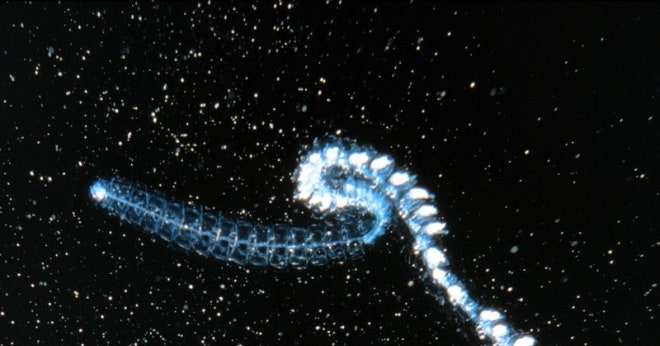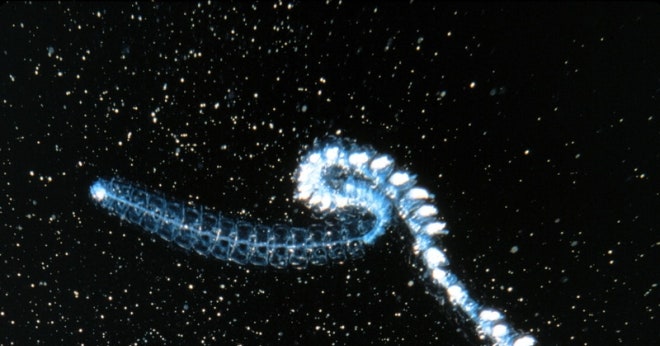I. Introduction: The Unseen Abyss
Imagine a world where sunlight cannot penetrate, bleak and cold, enveloped in vast darkness. The deep-sea environment is an otherworldly setting, filled with remarkable creatures that have evolved over millions of years to endure pressure, darkness, and cold temperatures. The unique adaptations of these creatures not only ensure survival but also demonstrate the complex interplay between biology and extreme environments. In this exploration, we uncover the fascinating secrets of deep-sea adaptations that defy our earthly expectations!
II. Bioluminescence: The Ghostly Glimmer
Bioluminescence stands out as one of the most striking adaptations observed in deep-sea creatures. Organisms like the anglerfish and certain jellyfish use bioluminescent abilities to communicate, attract prey, or deter predators.

Credit: Wired
In the pitch black of the deep, a flash of light can serve various purposes—it can be an invitation to mate or serve as an ominous warning. Researchers estimate that between 80 and 90 percent of deep-dwelling animals are bioluminescent, creating light by mixing the pigment luciferin with luciferase, the enzyme that makes it glow. This attribute is not only mesmerizing but pivotal, as it helps creatures navigate their dark world.
III. Surviving Extreme Pressure: A Harsh Reality
Deep-sea environments mean facing relentless, crushing pressures far superior to those experienced at sea level. The adaptations seen in deep-sea species, like the lack of rigid structures and the presence of specialized proteins, enable survival where conventional life would cease to function. Unlike submarines, which experience catastrophic implosion under immense pressure, species such as deep-sea octopuses thrive in these pressures. This leads one to wonder: what lessons can other biological systems teach us about pressure survival?
IV. Gigantism vs. Miniaturization: The Dance of Scarcity
In the abyss, food sources can be limited and unpredictable. Interestingly, this has led to trade-offs—some species develop gigantism, while others exhibit miniaturization. Giant squids reign large, reaching lengths of up to thirteen meters, a feat attributed to their ability to float gracefully in search of scarce resources. Meanwhile, some remarkable tiny species, too delicate to grow large, show that minimalist design can also have its advantages as they adapt to their environment.
V. Metabolism in the Abyss: Slow and Steady Wins the Race
Deep-sea animals frequently have slower metabolisms that pace their lives eternally, allowing species to gain longevity but often resulting in fewer offspring. For instance, certain deep-sea fishes thrive in this silent world for decades. Such revelations regarding metabolism exemplify how environmental adaptations can differ significantly depending on depth and habitat characteristics.
VI. Camouflage: The Art of Evasion
The art of camouflage is of utmost importance to evade predators among the various adaptations of the deep-sea. Many species use adaptive pigmentation or body shapes to avoid detection. Creatures such as the octopus seem almost to dissolve into their environments. The interplay of predator and prey drives many adaptations, where effective evasion is as critical accessory as the very tools used for pursuit.
VII. Conclusion: Discovery Awaits
The deep-sea ecosystem teems with life forms exhibiting adaptations fostered by extreme conditions. Beneath each layer lies novel complexities and mysteries of natural engineering that can teach various fields applicable lessons about adaptability during dire circumstances. As we gaze over our vast oceans, remember that beneath them lie ecosystems teeming with life just waiting for exploration—what astonishing adaptations might we yet discover hidden in these mysterious dark depths? Serving up vital information regarding our planet’s oceans, these communities offer insights as glaring as that glow of bioluminescence itself.
Categories: Adaptations, Biology, Do you know, Marine Life
Tags: Bioluminescent Creatures, Deep-Sea Adaptations, Extreme Environments, Marine Biology, Survival Mechanisms
Religion: None
Country of Origin: Global
Topic: Marine Adaptations
Ethnicity: N/A



